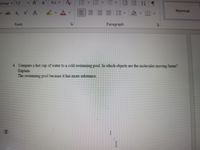. Compare a hot cup of water to a cold swimming pool. In which objects are the molecules moving faster? Explain. 5. An ice cube melts on a table. a. Is the ice cube losing or gaining thermal energy? Explain how you can tell. b. Energy cannot be made or lost. Where is the thermal energy coming from or going to? 6. A bottle of water freezes in the freezer. a. Is the water losing or gaining thermal energy? Explain how you can tell. b. Energy cannot be made or lost. Where is the thermal energy coming from or going to
Kinetic Theory of Gas
The Kinetic Theory of gases is a classical model of gases, according to which gases are composed of molecules/particles that are in random motion. While undergoing this random motion, kinetic energy in molecules can assume random velocity across all directions. It also says that the constituent particles/molecules undergo elastic collision, which means that the total kinetic energy remains constant before and after the collision. The average kinetic energy of the particles also determines the pressure of the gas.
P-V Diagram
A P-V diagram is a very important tool of the branch of physics known as thermodynamics, which is used to analyze the working and hence the efficiency of thermodynamic engines. As the name suggests, it is used to measure the changes in pressure (P) and volume (V) corresponding to the thermodynamic system under study. The P-V diagram is used as an indicator diagram to control the given thermodynamic system.
4. Compare a hot cup of water to a cold swimming pool. In which objects are the molecules moving faster?
Explain.
5. An ice cube melts on a table.
a. Is the ice cube losing or gaining thermal energy? Explain how you can tell.
b. Energy cannot be made or lost. Where is the thermal energy coming from or going to?
6. A bottle of water freezes in the freezer.
a. Is the water losing or gaining thermal energy? Explain how you can tell.
b. Energy cannot be made or lost. Where is the thermal energy coming from or going to
Trending now
This is a popular solution!
Step by step
Solved in 2 steps










